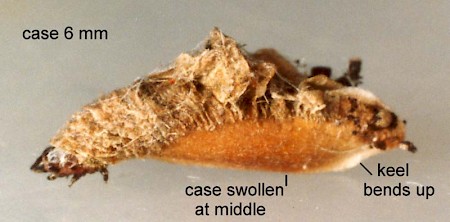
37.026 BF509
Coleophora violacea
(Ström, 1783)
Wingspan 9-11 mm.
The adult resembles several other brownish Coleophora species, and examination of the genitalia is advised. It may be separated from C. fuscocuprella by the distal quarter of the antenna; white in C. violacea and ringed white and brownish in C. fuscocuprella.
The moth flies in evenings and at night in late May and June in a wide variety of habitats throughout Britain. During the day it may be found resting on vegetation. The larva feeds on a wide range of trees, shrubs and herbs, favouring Rosaceae, but not exclusively.
The fully developed cased larva may be found active in October and again, after winter diapause, in April. Cases, about 6 mm, of diapausing larvae may be found through winter, fixed to a tree or fence post. The dorsal surface of the case is usually covered in leaf fragments, but they can sometimes be worn off almost smooth. The ventral surface is swollen at the middle and has a keel, which usually bends upwards at the posterior.
The cases of C. ahenella (on Rhamnus, Frangula, Viburnum and Cornus) and C. potentillae (case less swollen, keel not bent up, resting position less prone) are very similar. Much of the above is based on MBGBI 3.

 UKMoths
UKMoths 

